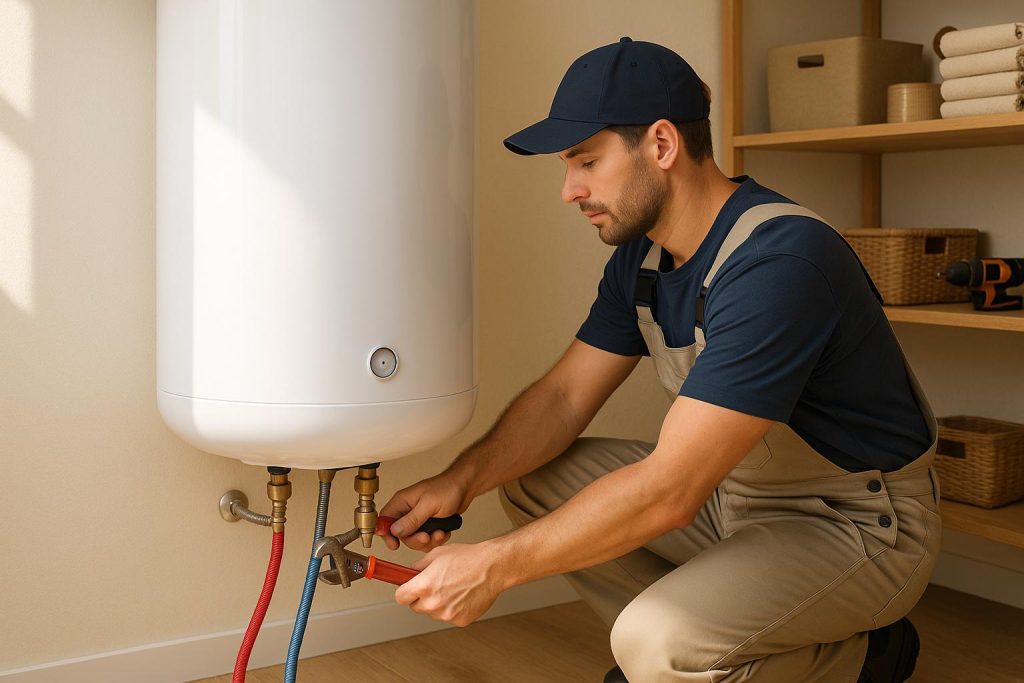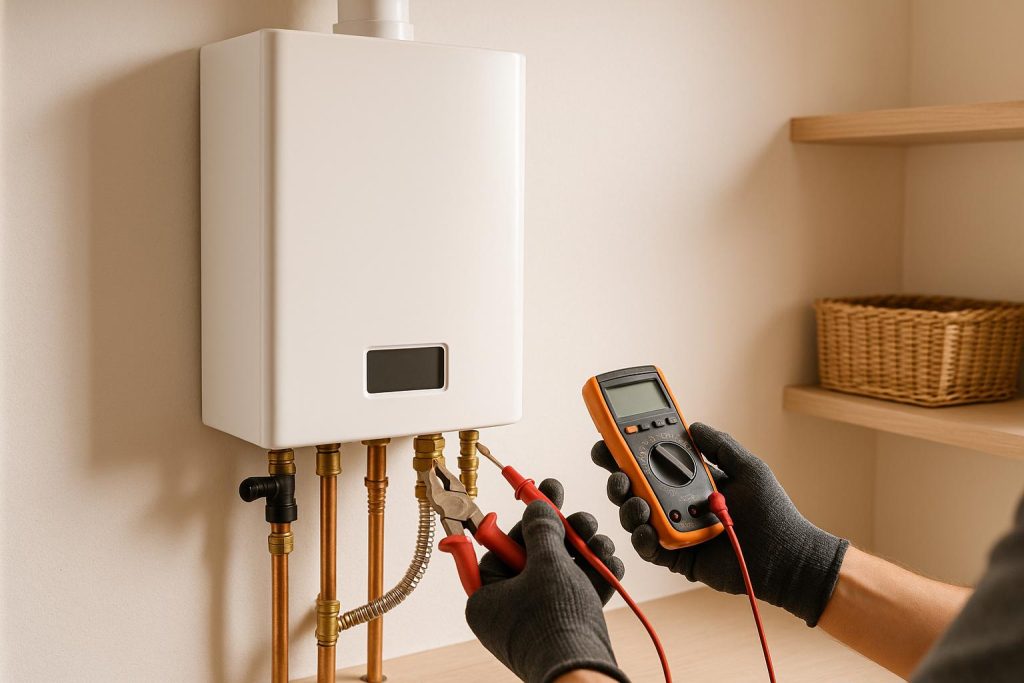
Sewer systems are essential for transporting wastewater from homes, businesses, and industrial facilities to treatment facilities or safe disposal areas. There are three primary types of sewer systems, each with distinct functions and operational mechanisms:
- Combined Sewer System (CSS):
- Function: CSSs collect and convey both sanitary sewage (from toilets, sinks, etc.) and stormwater runoff (rainwater) in a single integrated system.
- Operation: During dry weather, sanitary sewage flows through the sewer lines to treatment plants. During wet weather, the system can become overloaded, leading to combined sewage and stormwater discharges into natural water bodies.
- Challenges: CSSs can pose pollution risks due to overflows, impacting water quality and causing environmental problems.
- Sanitary Sewer System (SSS):
- Function: SSSs exclusively transport sanitary sewage, carrying wastewater from buildings to treatment plants.
- Operation: Wastewater from toilets, sinks, showers, and drains flows into the sanitary sewer system. These systems do not handle stormwater runoff, which is typically managed by separate stormwater drainage systems.
- Advantages: SSSs provide more consistent and controlled wastewater treatment, reducing the risk of pollution from combined sewer overflows.
- Maintenance: Regular inspection and maintenance are crucial to prevent blockages and maintain system efficiency.
- Storm Sewer System (SW):
- Function: Storm sewer systems are dedicated to managing stormwater runoff. They collect rainwater and direct it away from streets and properties to prevent flooding.
- Operation: Rainwater flows into catch basins or storm drains on streets, which then carry it through a network of pipes to natural water bodies or designated discharge points.
- Advantages: SW systems help mitigate urban flooding and reduce erosion caused by excessive runoff.
- Pollution Control: Some SW systems incorporate pollution control measures like oil and sediment traps to prevent contaminants from entering natural water bodies.
- Maintenance: Regular cleaning of catch basins and inspection of pipes are essential to ensure proper functioning.
1. Sanitary Sewer Systems
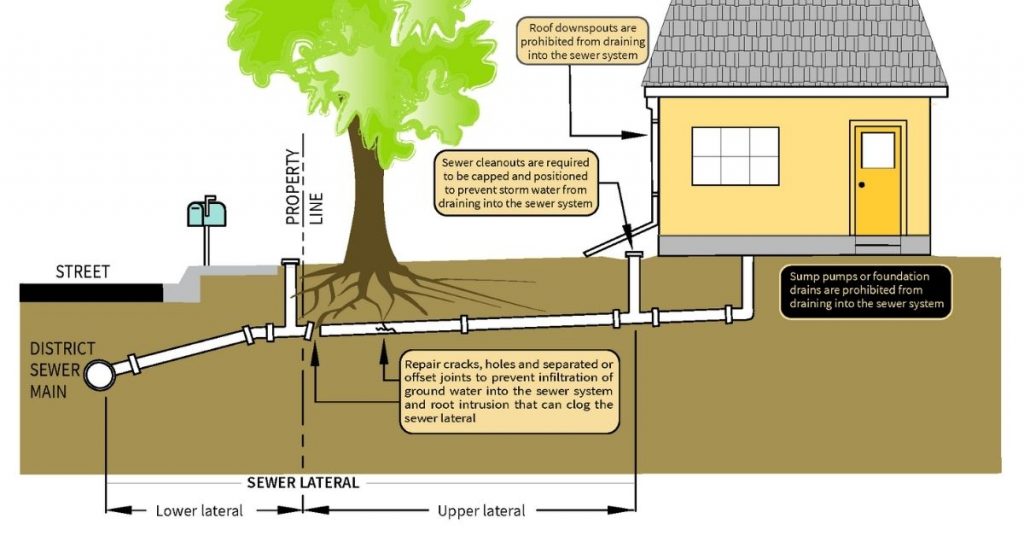
A sanitary sewer system refers to the sewer line which runs underground from your house and is connected to the public sewer line at the street. The private side of is also known as the main line or sewer lateral.
Waste is removed from your house via gravity. The sewer line is strictly installed with a certain pre-calculated slope which helps the waste to drain out without clogging the system which would result in backups.
Private sanitary sewer lines have a diameter of 4 inches but some could have a diameter of 6 inches. Their depths in the ground vary depending on the slope used and how far the house is from the street.
Your sanitary sewer line has 2 sections. These are the upper and the lower laterals.
The upper lateral is the section of the sewer line between your house and your property line. To gain access to the main line for sewer line inspection and cleaning, a sewer cleanout is usually installed on the upper lateral.
A sewer cleanout could be inside the house (in the basement) or outside the house but very close to the wall of the house. It will be sticking out a few inches from the ground with a square nut at the top of the cap.
The lower lateral is used to connect the upper lateral to the city’s sewer line. Although the upper lateral is strictly the responsibility of the homeowner, take your time to call your city to check if they are responsible for the lower lateral or if you are. It is different for different areas.
Once the waste from your house enters the public sewer line in the street, it is transported to the sewage treatment facility. There, it is treated before being circulated again for use.
As you can imagine, public sewer systems are installed across areas of varying altitudes. As such, the city cannot depend on gravity to transport the sewage to the treatment plants.
The sewage goes through a series of pumping stations along the path of the public sewer lines until it reaches the final destination. Any clogs or sewer backups in these lines is strictly the responsibility of the city.
As I mentioned clogs or sewer backs in your private sewer laterals are your responsibility. You should therefore avoid flushing wet wipes, rags, diapers, sanitary towels and anything else that is not human waste or toilet paper.
Avoid also pouring grease down the kitchen drain. Instead, pour it in sealable containers and trash it with your other home waste.
The public side of the sanitary sewer lines is accessed through manholes for maintenance. Private sewer laterals as I mentioned are accessed via sewer cleanouts and if the house has no cleanout a plumber will need to pull out a toilet or access the line from the plumbing vent.
I would recommend having your sewer line inspected and cleaned frequently especially if you have an old line or have lots of trees in your property. It is costly but better than having to deal with sewer backups.
2. Storm Sewer Systems
As we have seen, sanitary sewer systems remove waste and waste from inside the house, specifically from all fixtures with a drain. What then should you use to remove water from around your property to prevent flooding?
Storm sewers are designed to carry surface water also known as surface run off as a result of rainfall, melting snow and irrigation run off from around the house.
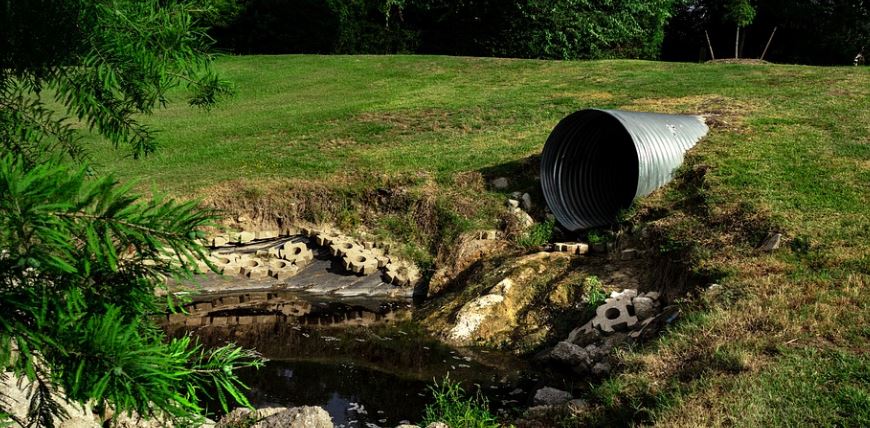
Houses and businesses are have storm drains installed which basically looks like manholes through which the surface water drains and flows out through underground pipes to the nearest water body.
If you have a French drain in your property, it is very possible that the French drains carries surface water from a place where it is likely to flood and drain it out into a storm drain.
It is important to mention that storm sewers do not drain into any sewage treatment facility. The runoff is deposited straight into the nearest river or stream.
It is therefore important to make sure that you do not pour/dump any toxic waste into a storm drain. The toxic waste will negatively impact water resources, marine life and basically the entire environment.
Just like sanitary sewer, storms sewer can also clog but they don’t clog as frequently as sanitary sewers. The responsibility is on the homeowner if the clog happens inside their property while out in the street the city will be responsible.
You can prevent storm sewer clogs by removing dirt/debris from around your storm drain and picking up tree leaves from your property frequently.
3. Combined Sewer Systems
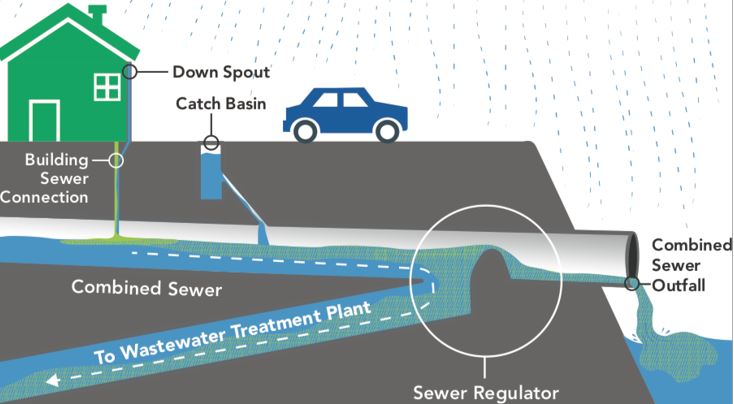
Combined sewer systems are designed to carry domestic waste, surface runoff and sometimes even industrial waste in the same pipe to a sewer treatment plant.
On the surface, combined sewer systems may look practical and even economical to run but that is however not the case. I will tell you why.
During dry weather, combined sewer systems work seamlessly and all the domestic waste, storm runoff (if any) and industrial waste are transported and treated in the sewage treatment facility. That however does not happen during wet weather.
Storm runoff combined with the other types of waste will overwhelm the sewer systems and that is they these systems are designed with an overflow to the nearest stream or river. These overflows are known as combined sewer overflows (CSOs).
The bad thing is that the CSOs not only contain storm runoff but also untreated sewage from homes and industries. These toxic wastes are deposited directly into the water bodies and will definitely negatively impact them.
Another thing to know about combined sewer systems is that they can result in a large volume of wastewater reaching the sewage treatment plant. The plant will therefore be overwhelmed and not treat the wastewater properly.
According to EPA, CSOs are an environmental concern for about 772 cities in the United States which have the combined sewer systems.
Wrap Up
And basically those are the 3 main types of sewer systems. I hope you enjoyed reading this post.


